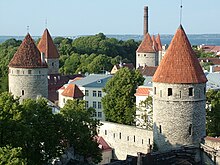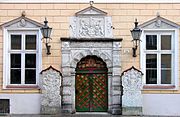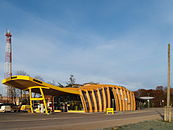Architecture of Estonia
| Part of a series on the |
| Culture of Estonia |
|---|
 |
|
People |
| Languages |
| Cuisine |
| Festivals |
| Religion |
| Sport |
This article covers the architecture of Estonia.
History
Ancient Estonia

A distinguishing feature of early Estonian architecture are the many strongholds and hill-forts found throughout the country, for example Varbola and Valjala strongholds. The more important of these, which could cover an area up to 1,000 square metres (11,000 sq ft) and were located at important crossroads, eventually developed into commercial hubs, like Tallinn, Tartu and Otepää.[1]
Gothic architecture

Christianity was brought to Estonia through the
The crusaders also left their mark on the country by erecting a large number of castles as a means to gain military and administrative control over the country. Both large castle complexes, called
The expansion and development of Estonian cities like Tallinn and Narva into
Baroque and Rococo
Baroque and Rococo architecture in Estonia is represented mostly by buildings erected by the
Classicism
The center of preserved neo-Classicist architecture is Tartu, the Town Hall and surrounding buildings from the 18th century. The main building of the University of Tartu (1803–09) is an example of High Classicism. Manor house architecture continue to dominate the countryside, with manors such as Saku, Kuremaa and Suure-Kõpu exemplifying the style. Some notable residences were also built in Tallinn, e.g. Stenbock House and the building on Kohtu street 8 (architect Carl Ludvig Engel, today housing the Estonian Chancellor of Justice), both on Toompea hill.
Late-19th-century architecture
As in the rest of Europe, the late 19th century was a time of architectural experimentation of styles in Estonia. Different types of historicism and eclecticism became common. Neo-Gothic became a popular style, not least among manor houses, as can be seen in Alatskivi or Sangaste manors.[5]
At the end of the period, Art Nouveau influences reached Estonia. Major sources of inspiration came were partly the vibrant Art Nouveau scene in Riga and partly Finnish national romanticism. Perhaps the most well-known architect who worked in Art Nouveau style in Estonia was Jacques Rosenbaum.[9]
The
20th century
Sillamäe city centre in its entirety is a noteworthy example of Stalinist architecture in Estonia.[10]
Gallery
-
Muhu St. Catherine's Church (13th century)
-
Koluvere Castle (begun 13th century)
-
Raeapteek (early 15th century)
-
House of the Blackheads, Tallinn (façade by Arent Passer) (1597)
-
Võru St. Catherine's Orthodox Church is an early example of classicism (1804)
-
University of Tartu main building (architect Johann Wilhelm Krause)(1803-1809)
-
Art Nouveau building in Tallinn (architect Jacques Rosenbaum, completed 1910)
Contemporary architecture
This section needs expansion. You can help by adding to it. (February 2013) |
-
Fahle building in Tallinn
-
Jõgeva bus station
See also
- Estonian Museum of Architecture
- Estonian vernacular architecture
- List of castles in Estonia
- List of palaces and manor houses in Estonia
- List of tallest buildings in Estonia
References
- ^ ISBN 0-8108-4904-6.
- ^ ISBN 9949-407-18-4.
- ^ A Hedonist's Guide to Tallinn By Laurence Shorter
- ISBN 0-8108-4904-6.
- ^ ISBN 0-8108-4904-6.
- ^ "Historic Centre (Old Town) of Tallinn". UNESCO. Retrieved 2013-02-10.
- ISBN 9949-407-18-4.
- ^ Culture And Customs of the Baltic States By Kevin O'Connor
- ISBN 978-9985-9828-7-7.
- ^ "What we consider our own". Estonica.org. Retrieved 10 February 2013.
External links
- Architecture Archived 2022-05-18 at the Wayback Machine entry on Estonica.org










